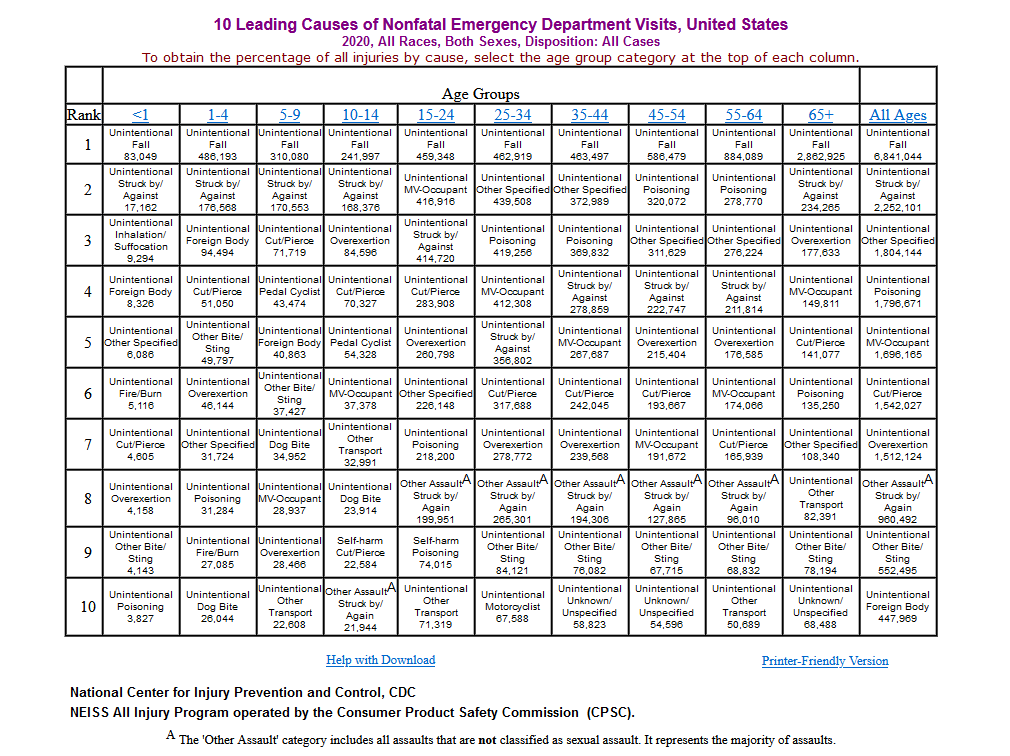Online Course
NRSG 780 - Health Promotion and Population Health
Module 12: Environmental Health, Occupational Health, Unintended Injuries and Violence
Unintended Injuries and ViolenceŚMagnitude of the Problem and Prevention
Magnitude of the Problem
Unintentional injuries and acts of violence are among the leading causes of death in the U.S. Unintentional injury is the leading cause of death for ages 1-44 and the fifth leading cause of mortality in the U.S.
More than 167,127 deaths from injury occur each year, one person every three minutes.

Source: https://injuryfacts.nsc.org/all-injuries/deaths-by-demographics/top-10-preventable-injuries/

Source: https://www.cdc.gov/injury/wisqars/LeadingCauses.html
Healthy People 2030 identifies injuries are a leading cause of disability for all ages, regardless of sex, race, ethnicity or socioeconomic status. CDC estimates that 2.5 million people are hospitalized and 27 million people are treated in emergency departments for injury each year. Unintentional falls are the leading cause of nonfatal injuries treated in hospital emergency departments and twice as prevalent as the non-fatal injuries that follow including unintentional struck by/against, unintentional overexertion, unintentional motor vehicle accidents.
Violence and injuries extend beyond the injured person to family members, friends co-workers, employers and communities and cost more than $671 billion in medical care and lost productivity each year. Each year in Maryland, more than $200 million in emergency department charges and $835 million in hospitalization charges are incurred as a result of injury.
Sources: Centers for Disease Control and Prevention. (2020). Leading causes of death. Available at https://wisqars-viz.cdc.gov:8006/lcd/home
Maryland Department of Health Preventing injuries in Maryland: A resource for state policy makers. Available at https://phpa.health.maryland.gov/OEHFP/Injury/Documents/MarylandResourceGuide2016HighRes.pdf

Sources: https://www.cdc.gov/injury/wisqars/LeadingCauses.html
Factors that affect unintentional injury and violence:
- Individual behaviors—alcohol use or risk-taking
- Physical environment in the home and community can increase/decrease risk of falls, fire road traffic injuries, drowning and violence
- Access to health services, ranging from prehospital to acute care to rehabilitation, effect the consequences of injuries including death and long-term disability
- Social environment
- Individual level—social norms, education, victimization history
- Social relationships—parental monitoring and supervision, peers, family interactions
- Community environment—cohesion in schools, neighborhoods, communities
- Societal-level factorsŚcultural beliefs, attitudes, incentives and disincentives, laws and regulations
Prevention
Violence and injuries can be prevented and their consequences reduced. CDC’s Injury Prevention & Control Center focuses on:
- Addressing Urgent Threats: Adverse Childhood Experiences (ACEs), Drug Overdose, Suicide Prevention
- Preventing Violence: Elder Abuse Prevention, Firearm Violence, Intimate Partner Violence Prevention, Sexual Violence Prevention
- Protecting Youth: Child Abuse & Neglect Prevention, datingMatters, Essentials for Childhood, Youth Violence Prevention
- Preventing Injury: Drowning, Transportation Safety, Older Adult Falls, Traumatic Brain Injury & Concussion
For more information click on https://www.cdc.gov/injury/index.html
The track record for success in prevention of unintentional injury and violence is strong. CDC identifies:
- School-based programs to prevent violence have been shown to cut violent behavior 29% among high school students and 15% across all grade levels.
- Comprehensive graduated drivers licensing programs show reductions of 38% in fatal and 40% in injury crashes among 16 year old drivers
- Seat belts have saved an estimated 255,000 lives between 1975 and 2008.
- Ignition interlocks, or in-car breathalyzers, can reduce the rate of re-arrest among drivers convicted of driving while intoxicated by a median of 67%
Source: Centers for Disease Control and Prevention (CDC). (2016). Saving lives and protecting people from violence and injuries. Available at https://www.cdc.gov/injury/about/index.html
For more information on injury prevention review Healthy People 2030 at https://health.gov/healthypeople/objectives-and-data/browse-objectives/injury-prevention
For more information on violence prevention review Healthy People 2030 at https://health.gov/healthypeople/objectives-and-data/browse-objectives/violence-prevention
International comparison studies show that traffic fatalities can be reduced substantially, if the U.S. begins to focus on scientific evidence when establishing traffic-safety policy. Estimates are as high as 20,000 lives saved each year in the U.S., if road user behavior is modified through sensible traffic laws targeting modest speed reductions and sober driver enforcement. Current studies show that road user behavior is responsible for 94% of crashes and it is not being adequately addressed. In the U.S., emphasis has been on vehicle design and manufacture which account for only 2% of deaths as compared to other countries where road user behavior is the focus.

Traffic fatality changes in the U.S. compared to Great Britain, Canada and Austria
For more information review the required readings on potential traffic fatality reductions:
- Evans, L. (2014). Traffic fatality reductions: United States compared with 25 other countries. American Journal of Public Health, 104(8), 1501-1507. Available at https://www.researchgate.net/publication/263053131_Traffic_Fatality_Reductions_United_States_Compared_With_25_Other_Countries
- Evans, L. (2014). Twenty thousand more Americans killed annually because U.S. traffic safety policy rejects science, American Journal of Public Health, 104(8), 1349-1351. Available at https://www.ncbi.nlm.nih.gov/pmc/articles/PMC4103206/
This website is maintained by the University of Maryland School of Nursing (UMSON) Office of Learning Technologies. The UMSON logo and all other contents of this website are the sole property of UMSON and may not be used for any purpose without prior written consent. Links to other websites do not constitute or imply an endorsement of those sites, their content, or their products and services. Please send comments, corrections, and link improvements to nrsonline@umaryland.edu.